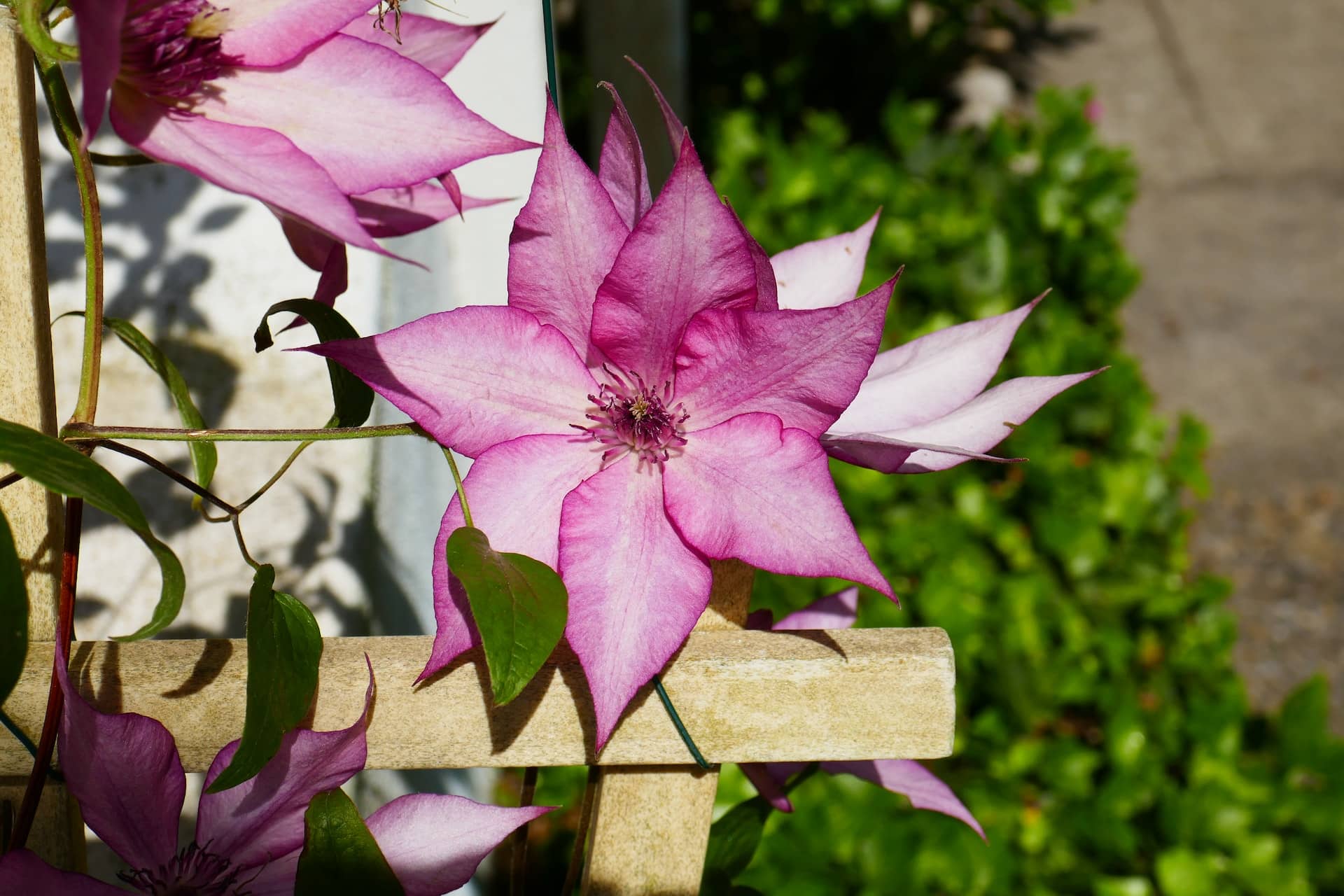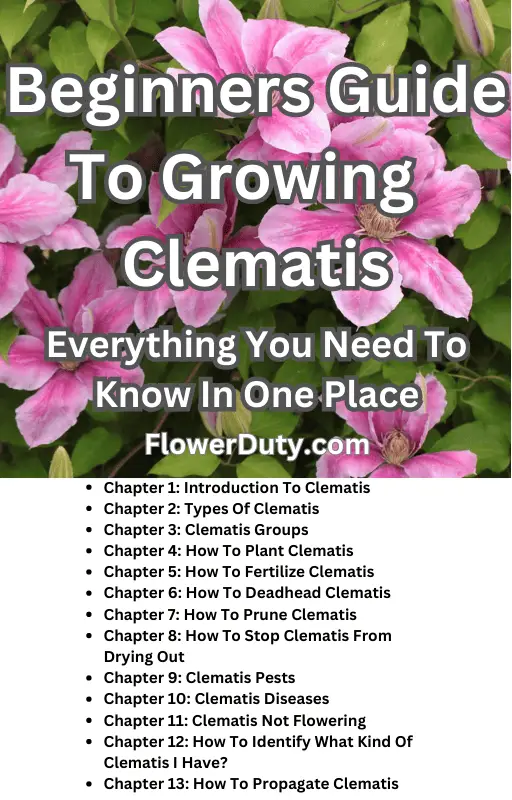Clematis can grow relatively well in poor soil, but you would be amazed at how bigger the flowers will be if you mulch them. Although Clematis will grow in almost any soil, but they do need a lot of extra nutrients when flowering, a couple of inches of mulch will not only provide these nutrients but also protect the topsoil from erosion.
Clematis plants can greatly benefit from a layer of mulch, such as well-rotted manure, bark chippings, stones, or natural shading from a small shrub. This is especially important if they are grown in a sunny and hot location, as it helps to retain moisture and regulate soil temperature. Additionally, it is advisable to perform a hard prune on all newly planted clematis during the first year.
One of the main reasons why you should always mulch your Clematis is because as these are shallow rooted plants they are really prone to drying out. Even mature clematis will have most of its roots in the top 10-20 inches of the topsoil. Clematis really need their roots to be moist and cool, and by far the easiest way to achieve this is to mulch them.
Just keep in mind that not all mulches are equal, if you want the mulch to also feed the Clematis, then you need to use organic mulches, if you want a mulch that doesn’t break down then you need to use inorganic mulches. If you want to know how to mulch Clematis, then check out my recent article Mulching Clematis ( In 4 Easy Steps ).
Best Mulch For Clematis
The best mulch for clematis is organic mulch, such as compost, shredded bark, or wood chips. Organic mulch not only provides insulation and moisture retention but also enriches the soil as it breaks down over time. It creates a favorable environment for clematis roots to thrive and encourages healthy growth and abundant flowering. When applying mulch, spread it evenly around the base of the clematis, ensuring a layer of about 2 to 3 inches thick. Be careful not to pile the mulch directly against the stem, as this can lead to moisture buildup and potential rotting.
Earn a 50% Commission on each sale by simply sharing my guides with friends and family on social media, check out Flower Duty Affiliates
Grass Clippings Mulch
Grass clippings are an excellent mulch even for the clematis, it will protect the topsoil from drying out, and will not allow water to evaporate, thus creating a moist environment around the roots of the Clematis, just how they like it. Grass clippings are readily available for most people who have a lawn, but under no circumstances use it as mulch if you have sprayed any kind of pesticide or insecticide on it.
The biggest pro of using grass clippings as mulch is that it breaks down in a matter of weeks, which means that the Clematis will be able to use the nutrients. The biggest con is that grass clippings tend to attract pests like slugs and snails. Although if you have a problem with these pests, you can always dry out the grass clippings before using them as mulch. If you want to know how to care for Clematis during the winter, then check out my recent article Clematis Winter Care ( In 5 Easy Steps ).
Wood Chips Mulch
Wood chips are one of the most common mulches used in gardens, and the main reason for this is because this mulch does look extremely good in the garden. Even a thin layer of wood chips will be enough to suppress most weeds, if you would use grass clippings for the same reason you would have to pile them up a bit. Although wood chips do break down, but it will take several years until they do, which means that you should not use this mulch for the clematis if you also want to feed it with the mulch.
The only thing to watch out for when using wood chips as mulch for clematis is to never cover the crown of the plant, as it might eventually die. Wood chips do not attract pests like other organic mulches do, although if your area has termites then it’s probably not a good idea to use this kind of mulch.
Manure Mulch
A thick layer of mulch made out of manure will do wonders in your garden, especially for hungry plants like the Clematis. The best part about manure is that you don’t even have to use a thick layer in order to see massive benefits. Manure is usually made out of cow or horse manure, and it is jam packed with nutrients. If you have the possibility to get manure that has already been treated with steam, then go for it.
Manure that has not been steam treated might contain a lot of weed seeds and even eggs of different pests. If you want to know how to deadhead Clematis, then check out my recent article How To Deadhead Clematis ( In 4 Easy Steps).
Chipped Bark Mulch
Chipped bark is very similar to wood chips mulch, the main difference is that the chipped bark mulch breaks down a lot faster. Wood chips take around 3 years to break down, and the chipped bark can take as little as a year to break down. Although chipped bark does suppress weeds, but you will find that some of them will still come through, so if you want a more hands off mulch then go with the wood chips.
The main reason why people use chipped bark is because it is cheap, and as it breaks down relatively fast it can be excellent for the Clematis.
Pine Needles
Pine needles are not that often used as mulch, mostly because not a lot of people have access to them. But if you live in an area where you can get a lot of pine needles, for free then you should definitely use them as mulch for the Clematis. Pine needles are excellent at suppressing weeds, and they also tend to break down relatively fast. The only downside is that a thick layer of pine needle mulch can make the soil somewhat acidic, but this is temporary, and the Clematis will be fine.
As a word of precaution, if your area tends to get forest fires, I would avoid using pine needles as mulch. On hot summer days, the pine needles can completely dry out, and they can easily ignite.
Hay Mulch
A lot of people think that hay and straw are the same, when in fact hay is made out of different grasses, and wildflowers, usually cut before they go to seed, and straw is the dried out stems of wheat or other plants. When it comes to which one is a better mulch, then hay is the obvious winner. Hay mulch has a lot more nutrients than straw and it also breaks down relatively fast.
The downside of hay mulch is that it can contain weed seeds or even the eggs of different pests.
Straw Mulch
Straw is made out of the dried stems of wheat, oats, and other plants that have already been harvested for their seeds. Straw has excellent weed suppressing properties, although it does not break down that fast. Generally speaking, straw is considered to be an excellent mulch, but the chances of it containing herbicides are fairly high. One of the ways farmers can keep monocultures, like wheat for example, is by using herbicides that kill off the other plants.
If the straw is contaminated with herbicides, then these chemicals will enter the soil as the straw breaks down, and sooner or later the Clematis will start to suffer.
Compost
Compost is not actually mulch, as compost has to be mixed in with the soil and the mulch has to cover the soil. Although I have heard a lot of people saying that compost is an excellent mulch, but the problem is that using compost as a mulch will not work. Compost doesn’t suppress weeds, it does the exact opposite, It will protect the soil for a while but it is only a matter of time until it dries out completely.
If you want to use compost in your garden, then make sure to cover it with some kind of mulch, like wood chips, grass clippings, and so on.
Key Takeaways
- The best mulches for the Clematis are organic mulches, these usually break down really fast and the Clematis will be able to use their nutrients. Grass clippings, wood chips, and manure mulches are considered to be the best ones for Clematis. Hay and straw mulches are also very good, but only if they have not been sprayed with any kind of herbicides or pesticides.
- Do not mulch Clematis with compost, as the compost doesn’t have any mulching properties.
- If you have a lot of slugs and snails in your garden, then dry out the organic mulches before using them as mulch.

